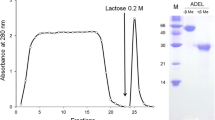Abstract
Male copepods in the genus Tigriopus use surface proteins of female copepods to recognize appropriate mates. In a previous study of pre-copulatory mate-guarding in T. japonicus Mori, a monoclonal antibody was developed against one protein that contributed to the attractiveness of female T. japonicus as mate-guarding partners. In the present study, which was performed between December 1998 and November 2000, the antibody was used to purify two proteins from homogenates of pooled T. japonicus. A 70 kD protein was partially sequenced using mass spectrometry, revealing sequence similarity to α2-macroglobulin. It was shown that the 70 kD protein was highly expressed in stage CV females, the most attractive stage for mate-guarding. A purified 36 kD protein was also shown to be a cognate of α2-macroglobulin. Because the structure of both the 70 and 36 kD proteins suggested that protease activity and its inhibition might play a role in male mate choice, three protease inhibitors were tested in bioassays of male discrimination of conspecifics. The male's ability to discriminate among females was not completely blocked by the protease inhibitor, but their behavior was affected in more subtle ways. This suggests that the 70 kD protein, designated CSP70, is a variant of α2-macroglobulin, but with more specific activity.





Similar content being viewed by others
References
Anstensrud M (1989) A vital stain for studies of behaviour and ecology of the parasitic copepod Lernaeocera branchialis (Pennellidae). Mar Ecol Prog Ser 53:47–50
Armstrong PB, Quigley JP (1992) Humoral immunity: α2-macroglobulin activity in the plasma of mollusks. Veliger 35:161–164
Barrett AJ, Starkey PM (1973) The interaction of alpha-2-macroglobulin with proteinases. Biochemistry 133:709–724
Blades PI, Youngbluth MJ (1979) Mating behavior of Labidocera aestiva (Copepoda: Calanoida). Mar Biol 51:339–355
Blades PI, Youngbluth MJ (1980) Morphological, physiological, and behavioral aspects of mating in calanoid copepods. In: Kerfoot WC (ed) Evolution and ecology of zooplankton communities. University Press of New England, Hanover, N.H., pp 39–51
Burton RS (1985) Mating system of the intertidal copepod Tigriopus californicus. Mar Biol 86:247–252
Enghild JJ, Thogersen IB, Salvesen G, Fey GH, Figler NL, Gonias SL, Pizzo SV (1990) Alpha-2-macroglobulin from Limulus polyphemus exhibits proteinase inhibitory activity and participates in a hemolytic system. Biochemistry 29:10070–10080
Hall M, Söderhäll K, Sottrup-Jensen L (1989) Amino acid sequence around the thiolester of alpha-2-macroglobulin from plasma of the crayfish, Pacifastacus leniusculus. FEBS Lett 254:111–114
Hergenhahn HG, Söderhäll K (1985) Alpha-2-macroglobulin-like activity in plasma of the crayfish Pacifastacus leniusculus. Comp Biochem Physiol B Comp Biochem 81: 833–835
Ito T (1970) The biology of a harpacticoid copepod, Tigriopus japonicus Mori. J Fac Sci Hokkaido Univ Ser VI Zool 17:474–500
Kelly LS, Snell TW (1998) Role of surface glycoproteins in mate-guarding of the marine harpacticoid Tigriopus japonicus. Mar Biol 130:605–612
Kelly LS, Snell TW, Lonsdale DJ (1998) Chemical communication during mating of the harpacticoid Tigriopus japonicus. Philos Trans R Soc Lond B Biol Sci 353:737–744
Kumari SS, Skinner DM (1993) Proteins of crustacean exoskeleton. II. Immunological evidence for their relatedness to cuticular proteins of two insects. J Exp Zool 265:195–210
Lazaretto I, Franco F, Battaglia B (1994) Reproductive behaviour in the harpacticoid copepod Tigriopus fulvus. Hydrobiologia 292/293:229–234
Mauchline J (1977) The integumental sensilla and glands of pelagic Crustacea. J Mar Biol Assoc UK 57:973–994
Quigley JP, Armstrong PB (1994) Invertebrate alpha (2)-macroglobulin—structure-function and the ancient thiol ester bond. Ann NY Acad Sci 712:131–145
Salvesen G, Enghild JJ (1993) Alpha-2-macroglobulins: detection and characterization. Meth Enzymol 223:121–141
Sokal RR, Rohlf FJ (1995) Biometry. Freeman, New York
Sottrup-Jensen L, Borth W, Hall M, Quigley JP, Armstrong PB (1990) Sequence similarity between alpha-2-macroglobulin from the horseshoe crab, Limulus polyphemus, and proteins of the alpha-2-macroglobulin family from mammals. Comp Biochem Physiol B Comp Biol 96:621–625
Spycher SE, Arya S, Isenman DE, Painter RH (1987) A functional, thioester-containing alpha-2-macroglobulin homologue isolated from the hemolymph of the American lobster (Homarus americanus). J Biol Chem 262:14606–14611
Thogersen IB, Salvesen G, Brucato FH, Pizzo SV, Enghild JJ (1992) Purification and characterization of an alpha-2-macroglobulin proteinase inhibitor from the mollusc Octopus vulgaris. Biochem J 285:521–527
Ting JH, Kelly LS, Snell TW (2000) Identification of sex, age and species-specific proteins on the surface of the harpacticoid copepod Tigriopus japonicus. Mar Biol 137:31–37
Acknowledgements
We acknowledge the assistance of the W.M. Keck Biomedical Mass Spectrometry Laboratory and the University of Virginia Biomedical Research Facility, which are funded by a grant from the University of Virginia Pratt Committee, for work on protein sequencing. This material is based on work supported by NSF Grant OCE-9503521 to TWS.
Author information
Authors and Affiliations
Corresponding author
Additional information
Communicated by J.P. Grassle, New Brunswick
Rights and permissions
About this article
Cite this article
Ting, J.H., Snell, T.W. Purification and sequencing of a mate-recognition protein from the copepod Tigriopus japonicus . Marine Biology 143, 1–8 (2003). https://doi.org/10.1007/s00227-003-1071-2
Received:
Accepted:
Published:
Issue Date:
DOI: https://doi.org/10.1007/s00227-003-1071-2




